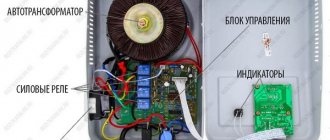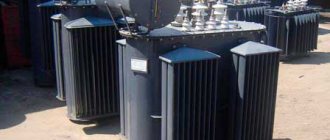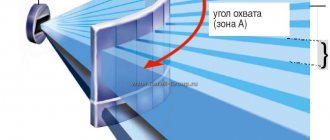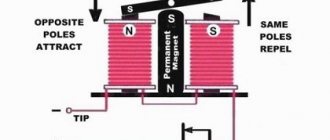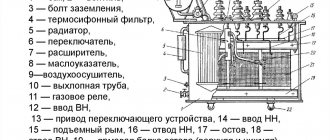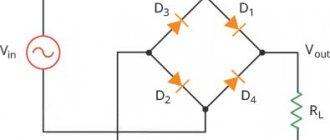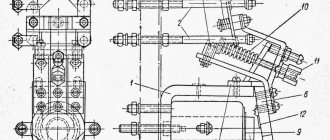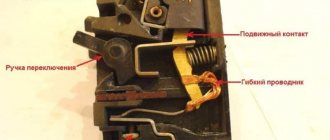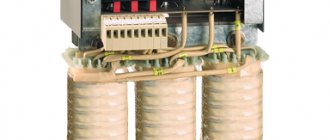Basic principles of organizing LZSH
Basic principles of organizing LPS (logical bus protection) when building a substation relay protection and automation system at terminals produced by RADIUS Avtomatika CJSC
Basic principles: 1. LZSh is implemented by the joint work of all feeder protections, as well as terminals installed on sectional and input switches.
2. The LZSh is designed to disconnect the input or sectional switch in case of damage to the busbars. This is one of the types of busbar protection that operates on the current principle.
3. LZSh in sectional and input terminals is implemented by the presence of another specialized MT stage, called the LZSh stage. It also has its own settings for current and time delay with an independent characteristic, but, unlike conventional MT protection stages, it also has two discrete inputs that block it - “LZSh blocking”.
4. From feeder protections, an output relay signal with the “Start overcurrent protection” function is required, generated immediately, without a time delay, when starting any of the introduced stages of the feeder overcurrent protection. Feeder protection itself can be implemented on any element base - LZSh can still be organized.
5. As a rule, the LZSh current setting is set quite high, designed to cause damage specifically to the busbars, although nothing prevents setting the setting with a not very large current to eliminate short circuits through a transition resistance, for example, an arc. The time setting of the LZSh stage, as a rule, is set within 0.2-0.3 s based on a compromise between fault detection, reliable blocking of the LZSh stage from feeder protections, but excluding the occurrence of significant damage in the cell.
6. The “Start MTZ” signals generated by the protections of outgoing connections act as blocking signals. In this case, this signal must be generated both at the start of the overcurrent protection and the current cut-off of the feeder protection. All “Start overcurrent” signals from the feeders of one of the bus sections are combined via OR and sent to one of the blocking inputs of the LSB stages of both the water terminal and the sectional one. The output relay “Start MTZ” in the Sirius-(2)-S terminal has two groups of contacts (“Start 1 MTZ” and “Start 2 MTZ”) for issuing them to both input protection terminals.7. The second blocking input of the LZSh input protection receives a similar signal “Start MTZ” from the sectional switch protection terminal “Sirius-(2)-S”. The second input of the sectional protection receives a signal to start the overcurrent protection of the feeder protections from the outgoing lines of the second section.
8. In each of the “Sirius-(2)-B, -(2)-C” terminals, both LZSh blocking inputs are internally combined by OR, that is, the presence of a signal at at least one blocking input prohibits the operation of the LZSh stage.
9. The “Sirius-(2)-S” terminal both receives the LZSh blocking signal from feeder protections to block its own LZSh stage, and issues the “MTZ Start” signal to block the LZSh input protection stage (with an “oblique” substation switching circuit).
10. To implement control of the integrity of the chain of supply of LZSh blocking signals to the inputs of the input protection terminals and sectional switch, in addition to the parallel circuit, there is also a sequential circuit for supplying these signals using the “Serial/Parallel” setting. In a sequential circuit, a logical unit must always be supplied to the blocking input from feeder protection, allowing the operation of the LZSh stage. That is, the LZSh input blocking input and both LZSh blocking inputs of the section will actually be “LZSh Resolution”. Such a signal is generated using a chain of normally closed contacts “Start MTZ” of all feeder protections connected in series. This scheme is more preferable and we recommend using it. With a parallel blocking circuit of the LZSh, any break in the blocking chain will lead to the operation of the LZSh during a short circuit on the feeder and extinguishing input. In a sequential circuit, on the contrary, if the circuit breaks, the LZSh will be put out of operation and, in addition, the terminal will signal a malfunction of the LZSh circuits.
11. If there is no active signal at any of these inputs for more than 100 seconds (or the “Talarm” setting), both terminals will generate a “LZSh Fault” signal with an indication on the screen and the “External fault” relay will be activated. The second blocking input of the LZSh input terminal, called “Input 2 LZSh” always operates according to a parallel blocking circuit and should be supplied with +SHU voltage through the normally open contact “Start MTZ” of the sectional switch protection (or not used at all).
12. The “Start MTZ” signal in the “Orion” and “Sirius” series terminals is issued in the event of operation of any MTZ stage (and MTZ-1 is usually a cut-off), including the LZSh, operating to shut down (that is, with the function turned on and working as a defense).
13. In the event of a short circuit behind the feeder switch, the cut-off or overcurrent protection of the feeder protection starts and the “Start overcurrent” signal begins to be issued. At the input, the LZSh stage can also immediately start, for example, with a close short circuit with a large fault current, but it will immediately be blocked by the “LZSh blocking” signal. When the feeder switch is turned off and the current decreases, the LZSh blocking signal will be removed, but the current will also disappear, and the LZSh will not start or operate.
14. In the event of a short circuit on the busbars, the LZSh stage will immediately start at the input terminal, no one will block it, and it will operate with its set time.
15. When the sectional switch is turned on, thanks to the “Start MTZ” signal from the Sirius-(2)-S terminal, the sectional switch will be selectively turned off in case of a short circuit on the far section of the buses, and the input switch - in case of a short circuit in the near one.
This scheme is more convenient and simpler, but is not protected from a break in the LZSh blocking circuit, which leads to false suppression of the input during a short circuit behind the feeder switch of outgoing lines (in the event of a circuit break). Therefore, it is proposed, whenever possible, to always use a sequential blocking circuit (see figure below).
according to information from RADIUS Avtomatika CJSC, March 2010
energoproekt.blogspot.com
Back-to-back logic bus protection algorithm
Currently, to protect medium and low voltage buses, differential and logical bus protection are used as the main ones.
We had the opportunity to take part in the design of a substation, on the medium voltage side of which the possibility of two-way power supply was provided. And although the use of differential protection in conditions of multilateral power supply seems, of course, the best, due to the high cost, it is impractical. Logical bus protection in its classical sense is not applicable, since its action may be non-selective. For example, during a short circuit in a transformer.
Today, small-scale energy is actively developing. To ensure uninterrupted power supply, for example, to consumers in the gas industry, low-voltage gas turbine units (up to 12 MW) running on associated gas are connected to low-voltage buses. The situation is similar in the oil industry, and not only. In this case, the number of connected generators can exceed 5 pieces. If there is a short circuit in any of the supply elements, the selectivity of the classical LZSh may be disrupted. In addition, if the section switch is constantly on and there is a short circuit on the protected section with the first time delay, the section switch will be switched off and only with the double input.
It is known that in multilateral power supply conditions, directional current protection is used. In its simplest form - with a positive sequence power direction relay. Directional current protections based on electromechanical and semiconductor elements have their drawbacks. The first is the presence of the so-called “dead zone,” which predetermined their use mainly for protecting lines. The second is long time delays, especially on power supplies (however, this applies to all current protection with time selectivity).
In microprocessor-based protection devices, the “dead zone” effect is eliminated, for example, using a memory “circuit”.
It is proposed to use a power direction device to ensure selectivity in the protection device of any obvious or potential “source”. It should provide two control actions - depending on the sign of the power - “one’s own” or “someone else’s”. “Own” - when the power is directed from the protected element, “foreign” - into the protected element.
The direction of the passing short-circuit power characterizes where the fault occurred: at “its” connection or “somewhere else”.
We can formulate the basic principles for implementing selective logical protection:
1. Two sets of directional protection must be installed on each power element: one to block the protection devices of other power elements, the second to turn off “its” circuit breaker.
2. For protections triggered in one direction of power, a circuit for blocking higher-level protections with lower-level ones must be assembled.
Note that all prerequisites have already been implemented in modern RZ terminals. Thus, in the basic versions of many there is a three-stage current protection function, and some or all stages can be directional.
It is possible to change the logic of issuing/receiving a blocking signal in protection devices at the factory programming stage.
So, let’s try to organize logical bus protection using the “35-9” circuit as an example. For this purpose, we plan to install two independent counter-directional LZSh stages, let's call them LZSh-I (direction to the tires) and LZSh-P (direction from the tires). The diagram is presented in Figure 1.
The power system can be conditionally divided into two areas: the area of external and the area of internal damage. In the event of a short circuit in the external fault area, the circuit breaker of the damaged connection must be turned off. In the event of a short circuit in the protected area, switches on all power supply elements.
Note that in case of damage in the area of external short circuits, some blocking stage LZSh-P will operate. A sign of a short circuit in the protected area is the simultaneous failure of all LZSh-P sets to operate.
The LZSh circuit can be assembled using a parallel or serial circuit. The most preferable seems to be a sequential circuit, which has the important quality of diagnosing an open circuit. The diagram is presented in Figure 2.
The logic that must be implemented in microprocessor devices installed on the supply inputs is shown in Figure 3.
Provided there are “sources” with significantly different powers, to ensure the necessary sensitivity, two current elements will be in demand, providing different current settings for LZSh-I and LZSh-P.
The operation settings LZSh-I and LZSh-P can be selected according to known conditions. LZSH-I - according to the condition of ensuring the necessary sensitivity. LZSh-P – according to the condition of detuning from maximum load currents.
I would like to note that such a change in logic will be in demand not only in terminals for the protection of “obvious sources” - transformer inputs, generators, SVs, but also in relay protection devices of “non-obvious” connections, for example, outgoing lines, along which, due to the specifics of their power facilities, can occur both consumption and generation of power. Or – powerful engines. Or - the receiving ends of parallel lines feeding the protected buses.
So, it is possible at the factory programming stage to additionally set the required number of stages of directional overcurrent protection, a power direction organ, and a “memory circuit”. Since all relays in microprocessor devices, with the exception of output ones, are virtual, the proposed change should not entail an increase in the cost of protection.
Counter-directional LPS can be used, firstly, on busbars of switchgears, for the protection of which the use of LPS seems inappropriate. These include 35 kV buses with a small number of substation connections, where modes of both output and consumption of power from the network are possible. Secondly, on the busbars of KRU-6 (10) kV power plants of small power, with generators running on them, where the use of high-speed arc protection is mandatory.
With the development of positive experience in operating the proposed algorithm, its scope of application may turn out to be even wider. For example, VN-LZSh can be installed on buses of 110 kV and higher as a backup in relation to DZSh. In this case, the power direction control must be performed with zero and negative sequence control.
The simultaneous use of differential, counter-directional logical and maximum current with time selectivity protection will increase the reliability of relay protection.
Thus:
1. The use of counter-directional LPS will make it possible in a number of cases to abandon the use of relay protection terminals with the DPS function and, as a result, reduce the costs of constructing new and reconstructing old power facilities.
2. The implementation of the proposed algorithm in relay protection terminals can be performed at the factory programming stage. And without increasing their cost.
3. Diagnostics against open circuit built into the algorithm of the LZH organization circuit, as well as the high reliability of microprocessor devices will ensure high reliability of the circuit as a whole.
4. The wide capabilities of digital devices have created the prerequisites for new algorithms for relay protection that have no analogues in previous generations of protection. In this article, this is logical bus protection with absolute selectivity.
Distance line protection - monitoring and control bodies. Lzsh protection what is it
Combined breaker failure protection and LZSh bus (Page 1) – Medium voltage relay protection – Advice from an experienced relay operator
I agree with fil. I downloaded the RE and became interested, and immediately came across the breaker failure protection function - a joint implementation of a failure backup device for the breaker failure switch and logical bus protection.
here is a quote from the function description -
“If the current protection is triggered on the outgoing line, the device generates a LZSh signal, which can be used to block a high-speed stage at the supply connections (i.e., to implement the LZSh function). "
When triggered on outgoing ones, as I understand it, the input settings are selective. Why block then?
Quote from the description of the ATS: The necessary conditions for starting the ATS are: - the presence of the “ATR ACTIVATION” signal (signal of the presence of voltage on the backup power source and the off state of the backup switch). Obviously it will not work, unless by backup we mean a sectional switch.
Quote from the description of the AVR: The second version of the AVR operation. When the “START AVR” signal appears and the switch is in the on state, after a time Tav the command “TURN OFF THE SWITCH” will be issued. When the “SWITCH OPEN” signal appears, the presence of the “ATR ACTIVATION” signal and the absence of blocking are checked. When these conditions are met, the “ENABLE ATS” command is generated. If there is no signal “ACTIVATE ATS”, then the device will wait for its appearance and when it appears, the command “ENABLE ATS” (turn on reserve) will be issued.
The ATS is triggered and there is no “ATS triggered” signal (which tells us that there is voltage on the backup source). Why then does the ATS trigger? What is most surprising is the phrase “the device will wait for its appearance and when it appears, the command “Enable ATS” will be issued. How long will it wait? And if the voltage is restored at the worker during this time, what then?
Having looked at the algorithm, I admit the idea that parallel operation of the main and backup inputs is possible.
www.rzia.ru
Relay protection: purpose, types, device
In accordance with the requirements of the rules of technical operation of electrical installations (abbreviated PTE), power equipment of electrical networks, substations and power plants themselves must be protected from short-circuit currents and failures of normal operation. Special devices are used as protective equipment, the main element of which is a relay. Actually, that’s why they are called that – relay protection and electrical automation devices (RPA). Today, there are many devices that can quickly prevent an accident in the serviced section of the power grid or, in extreme cases, warn personnel about a violation of the operating mode. In this article we will look at the purpose of relay protection, as well as its types and design.
What is it for?
First of all, we’ll tell you why you need to use relay protection. The fact is that there is such a danger as the occurrence of a short-circuit current in the circuit. As a result of a short circuit, conductive parts, insulators and the equipment itself are very quickly destroyed, which entails not only the occurrence of an accident, but also an industrial accident.
In addition to a short circuit, overvoltage, current leakage, gas release due to decomposition of oil inside the transformer, etc. may occur. In order to promptly detect danger and prevent it, special relays are used that signal (if equipment failure does not pose a threat) or instantly turn off the power in the faulty area. This is the main purpose of relay protection and automation.
Basic requirements for protective devices
So, in relation to relay protection and automation the following requirements are imposed:
- Selectivity. In the event of an emergency, only the area in which an abnormal operating mode is detected should be switched off. All other electrical equipment must work.
- Sensitivity. Relay protection must respond even to the most minimal values of emergency parameters (set by the response setting).
- Performance. An equally important requirement for relay protection and automation, because The faster the relay operates, the less chance there is of damage to electrical equipment, as well as danger.
- Reliability. Of course, the devices must perform their protective functions under the given operating conditions.
In simple words, the purpose of relay protection and the requirements for it are that the devices must monitor the operation of electrical equipment, respond in a timely manner to changes in the operating mode, instantly disconnect the damaged section of the network and alert personnel about an accident.
Relay classification
When considering this topic, one cannot help but dwell on the types of relay protection. Relay classification is presented as follows:
- Connection method: primary (connected directly to the equipment circuit) and secondary (connected through transformers).
- Execution options: electromechanical (a system of moving contacts disconnects the circuit) and electronic (disconnection occurs using electronics).
- Purpose: measuring (measure voltage, current, temperature and other parameters) and logical (transmit commands to other devices, carry out time delay, etc.).
- Method of influence: relay protection of direct influence (mechanically connected to the disconnecting device) and indirect influence (control the electromagnet circuit that turns off the power).
As for the types of relay protection systems themselves, there are many of them. Let’s immediately look at what types of relays there are and what they are used for.
- Overcurrent protection (overcurrent protection) is triggered if the current reaches the setting specified by the manufacturer.
- Directional overcurrent protection, in addition to the setting, the direction of power is controlled.
- Gas protection (GZ), used to turn off the pi
szemp.ru
Relay protection and automation
Relay protection and automation is a system designed to protect a substation from emergency operation. It is a complex complex of electrical and electronic devices. Relay protection and automation continuously monitor the state of the network and, if necessary, make various switches in it.
Any RZiA has selectivity (selectivity). Those. it turns off exactly that section of the power system where an abnormal or emergency operation has occurred. Accordingly, some consumers remain without voltage, and not all at once. This is especially necessary in cases where shutdown implies a violation of technical regulations. processes of enterprises accompanied by the risk of emergency situations or financial losses.
Zero sequence protection (ZNP): currents, principle of operation, circuits
One of the devices used to protect power lines with a voltage of 110 kV is directional current zero sequence protection (abbreviated as TNZNP).
These power lines are made with an effectively grounded neutral. Unlike 6-35 kV networks, in which the neutral is isolated, ground fault currents are quite large, which makes it necessary to record them and turn them off with the minimum possible time delay. But to do this, you need to not only determine the presence of a ground fault in the system, but also find the line on which it occurred. This is why such protections are made directional.
Zero sequence currents
A system of three-phase currents and voltages can be represented in the form of a vector diagram, where the vectors of these currents (voltages) in normal mode are shifted relative to each other in space by the same angle equal to 120 degrees. In this case, the resulting diagram is also rotating relative to the conditional observer: first, the phase vector “A” passes by him, then “B”, then “C”. And so - in a circle. This diagram is usually called a positive sequence current (voltage) system.
If you change the order of the vectors from A-B-C to C-B-A, you get the reverse sequence. In both cases, one thing remains unchanged: an angle of 120 degrees is maintained between the vectors of different phases.
Zero sequence current or voltage is obtained if all these vectors are added together. To do this, if you remember the geometry, you need to combine the beginning of the second vector with the end of the first, then also add a third to it. Since the angle between them remains equal to 120 degrees, we get an equilateral triangle, the system is closed. The resulting vector, which determines the sum of all terms, will be equal to zero. It must be drawn from the beginning of the first summable vector to the end of the last.
But this will only happen if there are no ground faults in the system. During phase-to-phase short circuits, the current vectors increase simultaneously in two phases, or even in all three. Adding them together will give the same zero. Therefore, such short circuits are also called symmetrical.
Watch an interesting video about the work of TZNP below:
Zero sequence current protection
But in the presence of a ground fault, the zero sequence of currents becomes unbalanced. A resulting current appears, to which the relay protection reacts.
In systems with an isolated neutral, a special transformer is used to separate these currents, which is placed on the cable.
On a 110 kV power line, this cannot be done and ground fault currents are determined according to a different principle. For this purpose, on conventional current transformers used for relay protection, a separate winding is allocated for each phase. The windings of the phases are connected to each other in series in a special way: the beginning of the next one is connected to the end of the previous one. The current windings of the relay are also included in the same circuit.
Typically, the protected area is divided into sections (zones), approximately like distance protection. The protection itself is multi-stage. The operating current of the first stage is maximum, the time delay is minimum or equal to zero. The next stage operates at a lower current, but with a longer time delay. And so on.
The same protection is installed at the other end of the line. And there can be many lines. The presence of stages makes it possible to ensure the disconnection of the damaged area, as well as to reserve other protections in the event of their failure.
Zero sequence voltage
Having only information about zero-sequence currents, it is impossible to determine where the short circuit occurred: in the line itself, or “behind the back.” At the opposite end of the line there is either a switchgear with other power lines connected to it, or transformers. They have their own defense that will understand the situation better.
In order to determine the direction of a ground fault, information about the zero sequence voltage is required. It is taken from special windings of voltage transformers connected in an open triangle.
This is also a vector sum, but not of currents, but of phase voltages. It is equal to zero in normal mode and with symmetrical short circuits, but with single-phase short circuits it has a certain value.
Next, the power direction relay comes into play. One of its windings is supplied with a zero-sequence voltage, and the other is supplied with a current used to operate the ground protection. Triggering occurs at an angle between these values when the short-circuit power is directed into the line. In other cases, with a short circuit “behind the back”, the failure of this relay to operate blocks the operation of the protection.
Unbalance currents
Correct addition of currents is only possible if the characteristics of the current transformers are completely identical. At the design stage, identical transformer windings with the same accuracy class and saturation factor must be selected for protection.
In addition, the circuits of these windings should not include other devices or instruments that violate the symmetry of their load.
But this may not be enough. If, despite all this, the magnetization characteristics turn out to be different, an unbalance current still appears. If in normal mode it does not lead to false operation of the protection, then with symmetrical short circuits, when the currents become several times larger, the unbalance current will increase significantly.
Therefore, when replacing current transformers, if it is not possible to find an analogue for one of them with full compliance with the current-voltage characteristics, then it is better to replace not one or two, but all three.
Implementation of TZNP protections
Protection panels for 110 kV power lines based on electromechanical relays, for example EPZ-1636, have been widely used since Soviet times. In addition to TZNP, it also includes distance protection and current cut-off.
However, electromechanical relays of panels in use have long expired, and their spot replacement does not always lead to reliable results.
Since progress has already gone far since the development of this relay technology, the old equipment is entirely replaced by panels or cabinets that include microprocessor relay protection terminals.
pue8.ru
Ticket 20 Question 2 Protection of busbars of stations and substations.
Logical bus protection (LBP) is widely used in distribution network substations without synchronous loads and synchronous generators. The operating principle of logical bus protection is as follows. At the input switch of the section, MTZ is performed either with two time delays (when using electromechanical protection), or two sets of MTZ are used (when using a digital terminal). The first stage (“fast” set) has a time delay of 0.15-0.2 s and performs the functions of the LZSh. It is put into operation if a fault current flows through the protection and there is no blocking signal from the starting elements of the protection of lines extending from the buses. This blocking signal is transmitted from the outgoing line protections to the LZSh set using a common blocking bus EBZ located along all cells of the section. If the outgoing line is damaged, then the starting protection elements of this line are triggered and the LZSh at the input is blocked (does not work), and the overcurrent protection of the input works with the usual selective time delay, reserving the protection of the line. Blocking is performed using a common output relay. If the tires are damaged, then there is no blocking signal from the outgoing lines and the LZSh (“fast” MTZ set) is activated, turning off the input switch after 0.15-0.2 s.
Disadvantages of LZSH. At substations with powerful synchronous electric motors (SMs) or generators, logical bus protection is not used due to the possibility of false alarms during external short circuits in the supply network and during post-emergency swings, when feed current from the SDs or generators or a swing current sufficient for starting passes through the input protection, and there is no blocking signal, since the protection of LEDs and generators, according to the principle of operation, does not work in this mode (for example, differential) or is detuned from it (for example, current cutoff). In addition, the LZSh does not work during a short circuit in the cell after the outgoing line protection current transformers.
Failure of a circuit breaker when disconnecting a short circuit can have serious consequences associated with the long-term flow of large currents through the equipment. To disconnect damage accompanied by switch failure, special breaker failure backup devices are used that disconnect switches of other electrical circuits that continue to feed the short circuit. The backup device will command the tripping of these breakers after sufficient time has elapsed for the protective relay to operate normally and to trip the breaker of the faulty circuit. The start-up of the backup device is carried out by the protection (main and backup) of the damaged element (line, transformer, busbars) simultaneously with the command to open the circuit breaker. If the breaker trips normally, the backup device circuit will return to its original position. If the switch fails during shutdown or the shutdown operation is delayed, the backup device, after the time delay set to it (0.3-0.6 s), will turn off the switches of the connections of the bus system from which the electrical circuit with the unswitched switch is powered. The command to turn off the circuit breakers is given by the breaker failure protection through the output intermediate relays of their selective bodies (or bus protection of the corresponding system). With other connection schemes, for example a polygon, the breaker failure protection operates selectively: it turns off the switches closest to the faulty one. As a result, not the entire electrical installation is switched off, but only part of it. Redundancy devices operated at substations are complex devices associated with the operational circuits of many protections, which increases the likelihood of incorrect operation of the breaker failure protection when faults occur in the protection circuits or erroneous closure of the contacts of the output protection relays. To prevent incorrect operation of the breaker failure protection device, in addition to the main starting element, their circuits provide an additional starting element that monitors the presence of a short circuit in the area of the breaker failure failure protection. An additional starting element prohibits (blocks) the operation of the breaker failure protection device in the absence of a short circuit. It is performed using current relays that respond to the passage of short-circuit current through a circuit whose switch has not been tripped. If the contacts of these relays remain open, the breaker failure protection does not operate in case of false and excessive operation of the protection relay. The serviceability of the breaker failure circuits is automatically monitored by a special intermediate relay. If a malfunction occurs in the circuit, the intermediate relay removes the operating current from the output circuits of the breaker failure failure and acts on a signaling device that notifies personnel of the malfunction. The redundancy device can be switched off by operating personnel completely, in semi-sets (at substations with a double bus system) or in separate circuits using operational pads. In addition, on the panel of each protection that initiates a breaker failure, there are overlays, the transfer of which “to the signal” stops the launch of a breaker failure from one or another protection. Personnel must perform operations with the linings when disconnecting the protection for maintenance, as well as when testing the effect of the protection on tripping the circuit breaker; in this case, the operation of disconnecting the breaker failure failure starting circuit should, as a rule, precede the disconnection of the protection. The breaker failure failure starting circuit is switched on after the protection is switched on.
studfiles.net
Relay protection
Distinctive features of the operation of power systems are:
- Rapidity;
- Interconnectedness;
- Coordination of procedures for the production, distribution and consumption of electrical energy.
To control all processes in the power system, special automatic control tools are used. All used automation devices, according to their purpose and scope of application, are divided into two classes:
- Local and system technological automation;
- Local and system emergency automation.
The purpose of system technological automation is to ensure the normal operation of the equipment, namely:
- Starting turbine-generator units and putting synchronous generators into operation;
- Automatic regulation of voltage and reactive power on power plant buses;
- Automatic frequency regulation and ensuring the power plant’s given load mode;
- Optimal distribution of electrical load between blocks;
- Voltage regulation in the distribution network;
- Regulation of frequency and power flow.
System emergency automation is designed to prevent and most effectively eliminate the consequences of accidents, namely:
- Protection of electrical equipment from short circuits and non-standard operating methods;
- Automatic switching on after the fault has been eliminated;
- Independent activation of backup equipment;
- Automatic frequency unloading;
- Automatic elimination of asynchronous mode;
- Self-preventing stability failures.
The main role among emergency equipment devices is played by relay protection, which evaluates the behavior of the electrical supply system and its components in modes of large negative influences and sharp jumps in electrical characteristics.
Negative reactions can be caused by a number of factors, namely:
- Breakdown or short circuit of insulating elements of power lines due to lightning influences or when they are contaminated;
- Breakage of wires or lightning protection grounding due to ice freezing or large fluctuations;
- Mechanical deformation of supports, damage to insulators, jamming of wires;
- Incompetent actions of operational personnel;
- Factory defective equipment.
The main objectives of relay protection are:
- Independent detection of a faulty element and its subsequent isolation. The protective system provides a signal to trip the switches of this component, creating acceptable operating conditions for the untouched part of the energy system;
- Independently detect unusual operating conditions and use measures to correct them. Deviation from the usual mode is primarily caused by various overloads, the shutdown of which is not necessary. Having unloaded the equipment, the protection communicates this error signal to the operating personnel.


